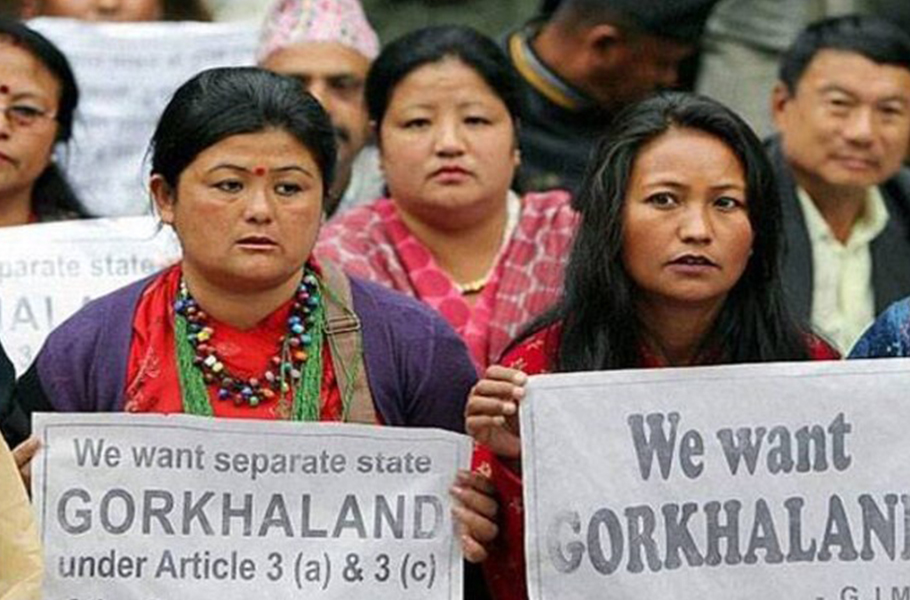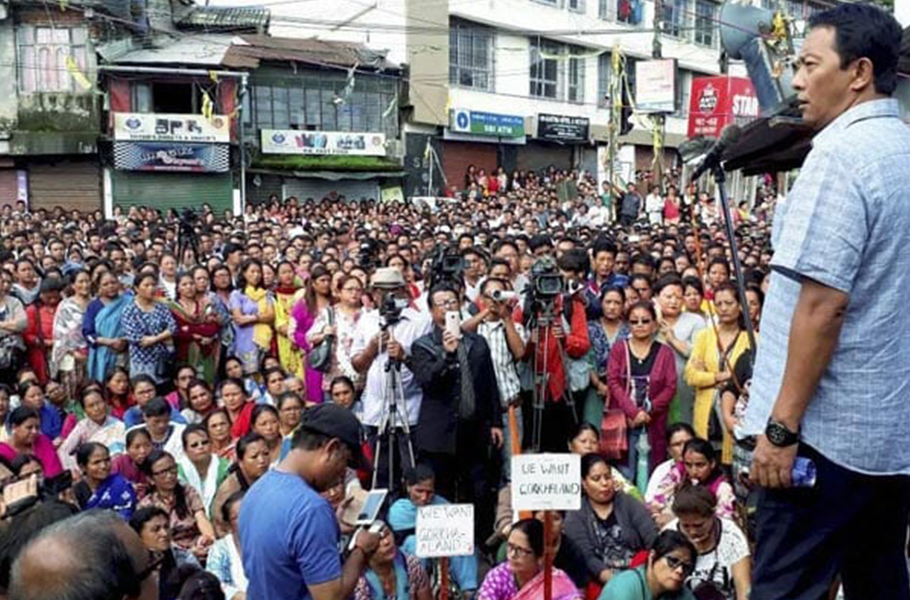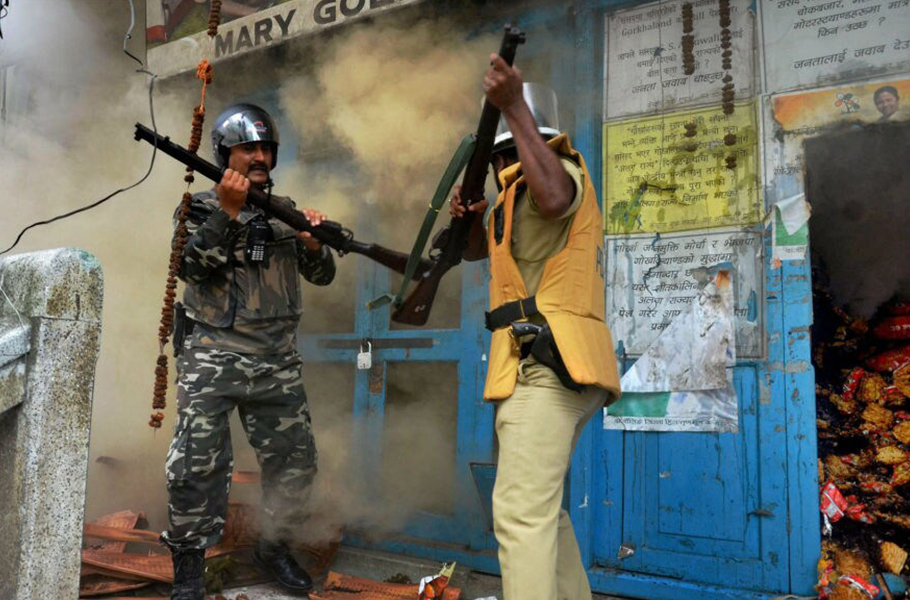
- Home
- News
- Analysis
- States
- Perspective
- Videos
- Education
- Entertainment
- Elections
- World Cup 2023
- Features
- Health
- Business
- Series
- Economy Series
- Earth Day
- Kashmir’s Frozen Turbulence
- India@75
- The legend of Ramjanmabhoomi
- Liberalisation@30
- How to tame a dragon
- Celebrating biodiversity
- Farm Matters
- 50 days of solitude
- Bringing Migrants Home
- Budget 2020
- Jharkhand Votes
- The Federal Investigates
- The Federal Impact
- Vanishing Sand
- Gandhi @ 150
- Andhra Today
- Field report
- Operation Gulmarg
- Pandemic @1 Mn in India
- The Federal Year-End
- The Zero Year
- Premium
- Science
- Brand studio
- Home
- NewsNews
- Analysis
- StatesStates
- PerspectivePerspective
- VideosVideos
- Entertainment
- ElectionsElections
- Sports
- Loading...
Sports - Features
- BusinessBusiness
- Premium
- Loading...
Premium

Darjeeling unlimited: What keeps the Gorkhaland cauldron simmering

Every time the snow-capped Kanchenjunga dazzles against the azure autumn sky, the Darjeeling hills beckons the travel-loving Bengalis. Darjeeling’s unmistakable Bong connection is soaked in romantic nostalgia. So much so that the place dotted with emerald green tea gardens, bejewelled by breath-taking mountains and nurtured by cascading waterfalls and meandering brooks, keeps propping up...
Every time the snow-capped Kanchenjunga dazzles against the azure autumn sky, the Darjeeling hills beckons the travel-loving Bengalis.
Darjeeling’s unmistakable Bong connection is soaked in romantic nostalgia. So much so that the place dotted with emerald green tea gardens, bejewelled by breath-taking mountains and nurtured by cascading waterfalls and meandering brooks, keeps propping up in Bengali literature and movies.
In real life too, catching a glimpse of the majestic Kanchenjunga while sipping a pot of the Darjeeling tea with freshly baked cakes or pastries at the hill station’s iconic century-old restaurant-cum bar Glenary’s or ambling along the Mall Road overlooking remnants of colonial-era architecture are part of many a romantic rendezvous of Bengalis spanning generations.
This romanticism with the hills, however, did not translate into development of the region comprising Darjeeling, Kurseong and Kalimpong that currently constitutes Gorkhaland Territorial Administration, a semi-autonomous administrative body under the West Bengal government. It also did not lead to socio-political integration of the Nepali-speaking population of the hills with their Bengali-speaking counterparts from the plains.
For instance, Kolkata that has roads named after Ho Chi Minh and Vladimir Lenin took ages to name a thoroughfare in the city after a Nepali luminary. It was only in 2008 that a portion of Alipur Road was renamed to immortalise 19th century Nepali poet Bhanubhakta Acharya, who translated Ramayana into Nepali.
On the contrary, the emotional-connect prompted quintessential Bengalis and their political leaders to undermine the socio-political aspirations of the hills fearing it would lead to losing Darjeeling, often described as the crown of the state by Chief Minister Mamata Banerjee.
The deprivation led to a local uprising which eventually snowballed into a violent agitation for a separate Gorkhaland state spearheaded by the Gorkha National Liberation Front (GNLF) formed by Subhash Ghisingh in April 1980. The movement primarily centred on identity.
A long road ahead
Over four decades and signing of two major peace accords later, the region’s development goals remain hostage to two competing emotions.
The powers that be in Kolkata are determined to not let go of Darjeeling. “There is no question of Gorkhaland. We will never allow Darjeeling to be carved out of Bengal,” says senior TMC leader and Lok Sabha MP Saugata Roy.
As for the Gorkhaland proponents, they lack a counter strategy and a roadmap to secure their demand. As a result, over the years, the movement has degenerated into an emotional political plank for some to capture power vested with the semi-autonomous administrative body.
“The demand for a separate state gave an excuse to the leaders spearheading it to grab local power without having to be accountable for anything else such as issues of development, unemployment…. They brainwashed the people to believe that once the ultimate solution (statehood) is realised, it will automatically take care of other issues,” said Harka Bahadur Chettri, a former MLA and senior politician from the hills.

This degeneration has never been as evident as in the past few months with internal squabbling in two main Gorkha parties, the GNLF and the Gorkha Janmukti Morcha (GJM) — leading to splits and formation of new political outfits.
“The proliferation of regional parties in the hills is the direct outcome of the leadership tussle among the parties espousing the Gorkhaland demand. This fragmentation of Gorkha leadership will definitely dilute and weaken their common cause for a separate Gorkhaland state,” pointed out Probir Pramanik, a Siliguri-based journalist, who has been covering Gorkhaland politics for over three decades.
The power chase
The latest to enter the already crowded political landscape of the hills is the Bharatiya Gorkha Prajatantrik Morcha (BGPM) or the Indian Gorkha Democratic floated by Anit Thapa, the former deputy chief of a breakaway GJM faction on September 9.
Two more political parties are waiting to be formed. Binay Tamang, the head of a GJM faction (Tamang faction) that he had formed with Thapa breaking away from the Bimal Gurung-led faction in 2017, also dropped a hint of forming a new party soon.

A senior GNLF leader and owner of the Glenary’s, Ajay Edwards, too, announced his decision to launch a new political platform following his differences with the front president and his childhood friend Mann Ghisingh, son of Subhash Ghisingh.
“We will launch a new political platform called the Ekta Manch within a couple of months,” Edwards said.
The political landscape of the hills is already overcrowded with a dozen parties. Two more additions to the list will take the tally to 14, quite a big number for a small region that has a population of just about 8.78 lakh, represented by one Lok Sabha MP and three MLAs.
The big pie
More than the Lok Sabha and assembly seats, all Gorkha parties would be interested to wrest power in the 45-member GTA, the election to which was last held in 2012. Bimal Gurung-led united GJM won all the 45 seats in that election.
The GTA is in a state of dishevel ever since Gurung and other members of the semi-autonomous body resigned en masse in 2017 in the wake of a violent agitation that broke out in the Darjeeling hills over a state government decision that Bengali language would be imposed in schools in the GJM-administered areas.
More than 10 people were killed in arson and clashes between the police and the agitators who had enforced a record 104-day strike in the GTA- administered Darjeeling hills.
While the agitation was still simmering in the hills, Gurung went into hiding to avoid arrest, the GJM suffered its first split, allegedly engineered by Mamata Banerjee. Gurung’s two close aides Tamang and Thapa distanced themselves from an absconding Gurung and called off the agitation.
In September 2017, Tamang was made chairman of the board of administrators to run the GTA by the state government.
Prior to 2017, Gorkhaland politics was dominated by one man and one party. Ghisingh took over the reins of the movement in 1980 with the formation of the GNLF. The separate state demand intensified in the mid-1980s.
After a spate of violence in which around 1,200 people were killed, a tripartite peace accord was signed between the GNLF, the state government and the Centre that led to the formation of the Darjeeling Gorkha Hill Council (DGHC) in 1988.
Despite allegations of corruption and one-upmanship, Ghisingh entirely dominated the hills’ politics as DGHC chairman until mid-2000. Ghisingh’s nemesis was a move to gain more autonomy for the council by bringing it under the Sixth Schedule of the Constitution.
Realising the financial and administrative limitation of a council formed under state acts, Ghisingh struck a deal with the state and the central governments in 2005 to reconstitute the DGHC under the Sixth Schedule that would have given it more autonomy.
It boomeranged as any autonomous council under the Sixth Schedule is meant for scheduled tribes, which constitutes only 28 per cent of the hills population. Among the generic Gorkha community comprising multiple ethnic groups, only Lepchas, Bhutias, Drukpas, Yelmos, Tamangs, Limbus and Sherpas are ST communities. Ghisingh was a Tamang, and hence an ST.
The non-tribal groups viewed the move as an attempt to undermine the 11 other non-tribal Gorkhas, who form the majority of the Darjeeling hills population. These communities are Bhujel, Dewan/Yakkha, Gurung, Yogi, Khas (Bahun and Chhetri), Magar, Newar, Rai, Sanyasi/Giri, Sunwar/Mukhia and Thami.
Objecting to the permanent Gorkhaland solution proposed under the Sixth Schedule, Bimal Gurung rebelled against Ghisingh and launched a fresh movement for a separate Gorkhaland under the banner of the GJM that he floated in 2007.
As his movement gained momentum, Gurung even forced Ghisingh to leave the hills in 2008 to emerge as an undisputed leader of the Gorkhas.
Old wine in new bottle
Peace was re-established, after a memorandum of agreement for the formation of GTA was signed by the GJM with the newly formed Mamata Banerjee-led state government and the Centre in 2011. Except for inclusion of the word ‘Gorkhaland’ in the name of the new council and transfer of a few lucrative revenue generation departments like Tauzi of the collectorate, the GTA was almost a replica of its previous avatar, the DGHC.
The Tauzi department looks after leasing out of land owned by the state government, including tea estates, renewal of lease, receiving annual rent etc.
The deal was a huge climbdown from the GJM’s original demand for a separate state. Nonetheless, Gurung had no problem in convincing the people of his “great achievement” towards the Gorkha cause.
“The word ‘Gorkhaland’ has been legitimised and this is a victory. We can now say we come from Gorkhaland,” he had told a mammoth rally held to celebrate the tripartite agreement in Darjeeling.
The “victory” reinforced Gurung’s status as an undisputed leader in the hills. He remained so until his sudden disappearance after police slapped several cases under the Unlawful Activities Prevention Act and for murder during the 2017 agitation.

But even then he had enough clout to help the BJP in absentia to win the Darjeeling Lok Sabha seat in 2019 elections. The BJP had then promised a “permanent political solution” to the pending issues in the Darjeeling hills.
Gurung’s political stock plummeted, changing the political contour of the hills, after in a surprise move he resurfaced in Kolkata in October 2020, barely six months ahead of assembly elections, to pledge support to Mamatata Banerjee’s Trinamool Congress.
The Gurung faction of the GJM that allied with the TMC drew a blank in the 2021 assembly elections. The other GJM faction led by Tamang, and also an ally of the TMC, won one out of the three hill seats. The TMC abstained from fielding candidates in the three hill seats and instead backed both the warring GJM factions.
The biggest gainer in the tussle between the GJM factions was the BJP that had won two seats with the support of the GNLF.
BJP joins the clamour
The BJP’s main poll plank in the hills was to find a permanent solution to the Gorkhaland issue with a promise that it would grant ST status to the 11 left out Gorkha sub-castes once the party assumed office in Bengal. The promise was made even though the Registrar General of India (RGI), the competent authority to give such a status, had already ruled out the possibility.
In response to an RTI query, the RGI pointed out that most communities among these 11 do not have the required attributes. It also apprehends declaring these communities ST would encourage the inflow of people from Nepal into Sikkim and Darjeeling.
Incidentally, the 2019 BJP manifesto also promised the inclusion of these communities in the Scheduled Tribe list. The granting of ST status to the remaining 11 communities would pave the way for Gorkhas to get more autonomy under the Sixth Schedule or the Article 244-A of the Constitution.
As pressure mounted on the BJP from various quarters, including its ally the GNLP, to fulfil its poll promise, the party’s Darjeeling MP Raju Bista in August announced that the Centre would convene a tripartite meeting on the “permanent political solution” in the first week of September and would invite the Bengal government to the talks.
The announcement did not materialise, triggering anti-BJP agitations in the hills, as Gorkhas feel that they have once again been taken for a ride. Meanwhile, newer parties continue to take shape contesting for political space claiming to keep the fight for Gorkhaland alive.
As a result, political bickering has overshadowed the demand for Gokhaland. But that doesn’t mean Bengal and Bengalis can afford to go on ignoring the identity demands of the Gorkhas for the sake of their nostalgia.

